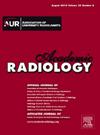Deep Learning in Knee MRI: A Prospective Study to Enhance Efficiency, Diagnostic Confidence and Sustainability
IF 3.8
2区 医学
Q1 RADIOLOGY, NUCLEAR MEDICINE & MEDICAL IMAGING
引用次数: 0
Abstract
Rationale and Objectives
The objective of this study was to evaluate a combination of deep learning (DL)-reconstructed parallel acquisition technique (PAT) and simultaneous multislice (SMS) acceleration imaging in comparison to conventional knee imaging.
Materials and Methods
Adults undergoing knee magnetic resonance imaging (MRI) with DL-enhanced acquisitions were prospectively analyzed from December 2023 to April 2024. The participants received T1 without fat saturation and fat-suppressed PD-weighted TSE pulse sequences using conventional two-fold PAT (P2) and either DL-enhanced four-fold PAT (P4) or a combination of DL-enhanced four-fold PAT with two-fold SMS acceleration (P4S2). Three independent readers assessed image quality, signal-to-noise ratio (SNR), contrast-to-noise ratio (CNR), and radiomics features.
Results
34 participants (mean age 45 ± 17 years; 14 women) were included who underwent P4S2, P4, and P2 imaging. Both P4S2 and P4 demonstrated higher CNR and SNR values compared to P2 (P<.001). P4 was diagnostically inferior to P2 only in the visualization of cartilage damage (P<.005), while P4S2 consistently outperformed P2 in anatomical delineation across all evaluated structures and raters (P<.05). Radiomics analysis revealed significant differences in contrast and gray-level characteristics among P2, P4, and P4S2 (P<.05). P4 reduced time by 31% and P4S2 by 41% compared to P2 (P<.05).
Conclusion
P4S2 DL acceleration offers significant advancements over P4 and P2 in knee MRI, combining superior image quality and improved anatomical delineation at significant time reduction. Its improvements in anatomical delineation, energy consumption, and workforce optimization make P4S2 a significant step forward.
膝关节MRI的深度学习:一项提高效率、诊断信心和可持续性的前瞻性研究。
基本原理和目的:本研究的目的是评估深度学习(DL)重建平行采集技术(PAT)和同时多层(SMS)加速成像的组合与传统膝关节成像的比较。材料和方法:对2023年12月至2024年4月接受膝关节磁共振成像(MRI) dl增强采集的成年人进行前瞻性分析。参与者接受T1无脂肪饱和和脂肪抑制pd加权TSE脉冲序列,使用传统的二次PAT (P2)和dl增强的四次PAT (P4)或dl增强的四次PAT与两次SMS加速(P4S2)的组合。三位独立的阅读者评估了图像质量、信噪比(SNR)、对比噪声比(CNR)和放射组学特征。结果:34例受试者(平均年龄45±17岁;14名女性)接受P4S2、P4和P2显像。与P2相比,P4S2和P4均表现出更高的CNR和SNR值(结论:P4S2 DL加速在膝关节MRI中比P4和P2有显著的进步,结合了更好的图像质量和改进的解剖描绘,显著减少了时间。它在解剖描绘、能耗和劳动力优化方面的改进使P4S2向前迈出了重要一步。
本文章由计算机程序翻译,如有差异,请以英文原文为准。
求助全文
约1分钟内获得全文
求助全文
来源期刊

Academic Radiology
医学-核医学
CiteScore
7.60
自引率
10.40%
发文量
432
审稿时长
18 days
期刊介绍:
Academic Radiology publishes original reports of clinical and laboratory investigations in diagnostic imaging, the diagnostic use of radioactive isotopes, computed tomography, positron emission tomography, magnetic resonance imaging, ultrasound, digital subtraction angiography, image-guided interventions and related techniques. It also includes brief technical reports describing original observations, techniques, and instrumental developments; state-of-the-art reports on clinical issues, new technology and other topics of current medical importance; meta-analyses; scientific studies and opinions on radiologic education; and letters to the Editor.
 求助内容:
求助内容: 应助结果提醒方式:
应助结果提醒方式:


